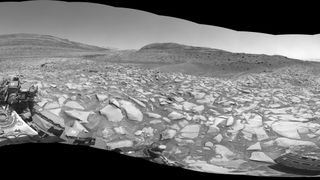
Currently in the twelfth year of its mission, NASA's Curiosity rover continues to press on while treading the world of Mars, delving into areas no rover has gone before. The latest phase of Curiosity's adventure has brought it to what some scientists believe is the desiccated bed of an ancient river.
As Curiosity prepares to follow Gediz Vallis, as scientists call this winding and boulder-choked channel, it will try to give scientists a look back through time so they can discover how the landform came to be in the first place
Originally slated for a two-year-mission, Curiosity continues to trawl the Martian surface in search of new insight into the Martian environment and life that might have once lived — or still lives — on the Red Planet. Since 2014, the rover has been ascending the foothills of Mount Sharp, which rises 3 miles (5 kilometers) above the rover's original landing site in Gale Crater.
Gediz Vallis snakes through Mount Sharp. Billions of years ago, the mountain — as with the rest of Mars — would have been significantly wetter than it is today. Over time, as Mars dried up, wind and remnant water eroded the mountain into the layers Curiosity can see today. Scientists believe some force of Martin nature carved the Gedis Vallis channel into Red Planet slopes during this drying time.
It's possible that wind created Gediz Vallis — however, the channel's sides are steeper than scientists would expect from a wind-carved vale. Thus, it's possible the channel is the work of landslides stemming from further up the mountain, which might have deposited boulders and other rocky debris that Curiosity spotted filling Gediz Vallis' floor. Or, perhaps more enticingly, it's possible Gediz Vallis was formed by flowing liquid water.
"If the channel or the debris pile were formed by liquid water, that's really interesting. It would mean that fairly late in the story of Mount Sharp — after a long dry period — water came back, and in a big way," said Ashwin Vasavada, Curiosity's project scientist at NASA’s Jet Propulsion Laboratory, in a statement.
Get the Space.com Newsletter
Breaking space news, the latest updates on rocket launches, skywatching events and more!
Curiosity will spend months exploring the channel, looking at more than just the Martian past. The rover doesn't have the capability to summit Mount Sharp, so looking up from the channel is the best way it can help scientists learn more about what lies up there.
Join our Space Forums to keep talking space on the latest missions, night sky and more! And if you have a news tip, correction or comment, let us know at: community@space.com.

Rahul Rao is a graduate of New York University's SHERP and a freelance science writer, regularly covering physics, space, and infrastructure. His work has appeared in Gizmodo, Popular Science, Inverse, IEEE Spectrum, and Continuum. He enjoys riding trains for fun, and he has seen every surviving episode of Doctor Who. He holds a masters degree in science writing from New York University's Science, Health and Environmental Reporting Program (SHERP) and earned a bachelors degree from Vanderbilt University, where he studied English and physics.
